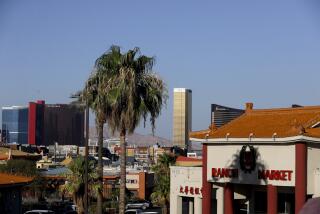A Burst of Religious Activity in ‘Sin City’ of Las Vegas : 1st Mormon Temple in Nevada Due
LAS VEGAS — Thirteen miles east of the downtown casinos, an $18-million, white stone structure with a gleaming copper roof and a labyrinth of rooms will be ceremoniously opened in the fall.
Rather than another hotel and gambling resort in fast-growing Las Vegas, however, it will be the first Mormon temple built in Nevada.
The Church of Jesus Christ of Latter-day Saints, headquartered in Salt Lake City, builds temples to perform baptisms by proxy for the dead, marriages sealed for eternity and other rituals the Mormons term “special blessings that can only be obtained in His holy house.”
“Some people wonder why we would establish our holy place in the middle of all this,” said Bob Christiansen, the Mormon Church’s media spokesman for southern Nevada. About 90,000 Mormons, including children, live in Nevada--about 10% of the state’s population.
‘We Have to Make a Choice’
Mormons are taught not to smoke or gamble, nor drink caffeinated or alcoholic beverages, much less indulge in sexual titillation or prostitution--all of which are within easy reach here.
By the same token, Christiansen said, Nevada Mormons who maintain a good standing in the church earn admiration as stalwarts of the faith. “We have to make a choice,” he said.
Church officials emphasized to reporters, who were given an early look inside the temple, that members are not automatically disqualified from temple rites if they work in the gambling business--one that took in $3.1 billion last year in gross revenue. Each adult’s circumstances and worthiness are evaluated individually by local church leaders, officials said.
Even so, only about 7,500 members in the Las Vegas region have fulfilled requirements necessary to gain admittance, according to Boyad Tanner, president of the Las Vegas temple. Another 4,500 Mormons in northern Nevada, the Barstow and Blythe areas of California and parts of northwestern Arizona have also met temple requirements and will be served by the Las Vegas temple, he said.
Worship Services
Mormons conduct regular worship services and baptize themselves in church buildings.
However, for rites unique to Mormonism the Nevadan members have had to travel to temples in three neighboring states.
As is customary, the church will offer public tours of the facility once it is completed, in about three months. Then, the church will prohibit outsiders from entering after its consecration. That policy is explained by a church spokesmen as natural because of the “sacred and private” temple activities.
But because the church, founded in 1830 by Joseph Smith in New York State, has distinctive beliefs and practices, the closed-door policy may serve to shield members from ridicule as well as enhance the sense of holiness.
Each Mormon temple (including the nearest ones in Los Angeles, Oakland, Phoenix, and St. George, Utah) have a “celestial room.” Reporters escorted into the celestial room at the Las Vegas temple were told by a guide that it will be “the most beautiful in the temple”--although that was hard to imagine this week in its unfinished state amid tools and bare concrete floors.
Room for Reflection
Mormons enter that room for reflection after rites called the endowments--instruction on church tenets about the afterlife and vows of obedience and purity.
The temple has 192 rooms on three floors, the largest of which can seat 300 people. One of the most important rooms is in the basement and contains a huge baptismal font. Twelve life-size statues of oxen supporting the font--standard in Mormon temples--were not yet in place.
Qualified Mormons perform baptisms by proxy for deceased ancestors who never had the opportunity to join the church. That is a major incentive for the vast genealogical research done by Mormons. The Mormon Church maintains that there is Christian precedent. The Apostle Paul referred to baptism of the dead in his first letter to the Corinthians.
As explained here by Elder Ronald E. Poelman, a member of the church’s First Quorum of the Seventy, the ancestors offered baptism are presumed to have the right to refuse the baptism. “They have free choice just as we do on Earth,” Poelman said.
Reporters were also escorted past banks of lockers where men and women in separate dressing areas will change into all-white clothing for Temple rituals.
Special Undergarments
Mormons who have completed certain rites are expected to wear special temple undergarments, which are embossed with sacred symbols, outside the temple as well.
“If you didn’t look closely, you couldn’t tell the difference from ordinary men’s boxer shorts and women’s undergarments,” said Elder M. J. Wilcox, a missionary in Las Vegas.
The church derives the practice from references to temple rites in the Old Testament, he said.
“Wearing the undergarments on a daily basis is a continuing reminder to us all of our covenants and commitments,” Poelman said.
More to Read
Sign up for Essential California
The most important California stories and recommendations in your inbox every morning.
You may occasionally receive promotional content from the Los Angeles Times.










